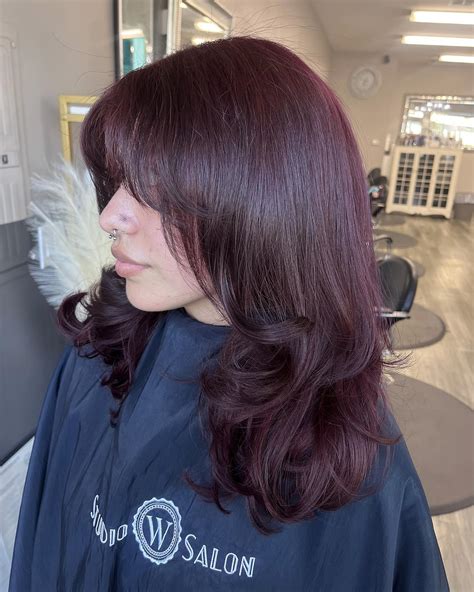Introduction:

Cutting-edge hair trends have taken the world by storm, and two styles that have captivated the masses are the butterfly cut and the wolf cut. Both featuring layers, choppy textures, and an edgy vibe, these hairstyles have become the talk of the town. But what exactly sets them apart? Allow us to delve into the captivating differences between the butterfly cut and the wolf cut.
Section 1: Defining the Butterfly Cut
- Origin and Inspiration: The ethereal butterfly cut seems to be inspired by the delicate wings of butterflies, incorporating soft layers that dance around the face.
- Key Features: Delicate layers start from the crown of the head, gradually increasing in length towards the bottom. The front layers may be styled to create a framing effect, while the back layers can be cut to form a soft, feathered look.
- Suitable Face Shapes: The versatile butterfly cut flatters a wide range of face shapes, from oval to square and even round. Its layers create volume and movement, balancing out sharp angles and softening softer features.
Section 2: Decoding the Wolf Cut
- Origin and Evolution: The wolf cut emerged from the fusion of the classic shag and mullet haircuts, embracing a bold, edgy, and androgynous aesthetic.
- Key Features: This cut features short, choppy layers on top, blended into longer layers towards the bottom. Choppy bangs often accompany the wolf cut, framing the face and adding an extra layer of texture.
- Suitable Face Shapes: The wolf cut is best suited for oval or heart-shaped faces. Its choppy layers can be customized to enhance the cheekbones and jawline, accentuating the angles and creating a striking silhouette.
Section 3: Butterfly Cut vs. Wolf Cut: The Layer-by-Layer Comparison
-
Layer Structure:
– Butterfly Cut: Soft, feathered layers that start from the crown and gradually increase in length.
– Wolf Cut: Choppy, edgy layers on top, blending into longer layers below. -
Bangs:
– Butterfly Cut: Optional, may be styled to frame the face.
– Wolf Cut: Often features choppy, textured bangs. -
Volume:
– Butterfly Cut: Creates moderate volume, especially around the crown.
– Wolf Cut: Generates more volume, particularly in the upper layers. -
Maintenance:
– Butterfly Cut: Requires regular trims to maintain the layered shape.
– Wolf Cut: Needs more frequent touch-ups to keep the choppy layers defined.
Section 4: Embracing the Butterfly Cut vs. Exploring the Wolf Cut
-
Personal Style and Aesthetic:
– Butterfly Cut: A delicate and feminine style that suits those who prefer a softer, more ethereal look.
– Wolf Cut: A bold and edgy style that resonates with individuals who are not afraid to make a statement. -
Face Shape and Hair Texture:
– Butterfly Cut: Suitable for a wide range of face shapes and hair textures.
– Wolf Cut: Most flattering for oval or heart-shaped faces with medium to thick hair textures. -
Occasion and Context:
– Butterfly Cut: Can be dressed up or down, making it appropriate for various occasions.
– Wolf Cut: Ideal for casual, edgy settings and events where a more rebellious style is desired.
Section 5: Tips and Tricks for Butterfly Cut and Wolf Cut
-
Butterfly Cut:
– Use a round brush to blow-dry the hair, enhancing the softness and volume of the layers.
– Add some texturizing spray to enhance the layers and create a more ethereal effect. -
Wolf Cut:
– Use a diffuser to blow-dry the hair, preserving the choppy texture and creating a voluminous, wild look.
– Apply a volumizing mousse before blow-drying to boost volume and accentuate the choppy layers.
Section 6: Common Mistakes to Avoid
-
Butterfly Cut:
– Over-styling the hair, leading to a rigid and unnatural look.
– Cutting the layers too short, resulting in a choppier appearance than desired. -
Wolf Cut:
– Creating too many layers on top, making the hair look unbalanced and unkempt.
– Cutting the bottom layers too long, diminishing the wolf cut’s signature choppy texture.
Section 7: Conclusion
The butterfly cut and the wolf cut are two distinct hair trends that cater to different tastes and styles. While the butterfly cut exudes a delicate and ethereal charm, the wolf cut embraces an edgy and rebellious vibe. Understanding the differences between these two styles enables individuals to make informed choices that complement their personal aesthetic, face shape, and lifestyle. Whether you prefer the soft elegance of the butterfly cut or the bold energy of the wolf cut, these haircuts empower self-expression and allow one to embrace their individuality with confidence.
